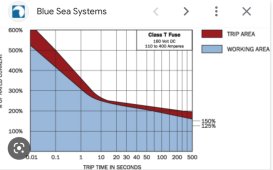MrM1
I'm Here, But I'm Not All There
Can't tell right now because it has no power. It lost power when the fuses blew.Did the Victron shunt record anything interesting?
But I did notice the little in line fuse in the shunt power wire was still good.
Can't tell right now because it has no power. It lost power when the fuses blew.Did the Victron shunt record anything interesting?
Can't tell right now because it has no power. It lost power when the fuses blew.
But I did notice the little in line fuse in the shunt power wire was still good.
I certainly will check thatOnce you get some power to it, the logs might tell you how long it was "running" before it blew. Would also show reduced voltage, maybe the peak amps.. who knows. That thing might be a goldmine.
This will certainly be one of my first considerationsCould something metal have fallen during the move. That shorted and blew the first fuse? Then the loads got the second one?
Yup agreed. And thx, lots of options.Another scenario that could have happened.
When they powered everything back up. The capacitor surge was enough to shut down the BMS's. But, one of them wasn't fast enough to save the fuse. Then after 10 minutes of running. The loads were enough to take out the second fuse. Although, the BMS should have saved the second fuse. Assuming that the BMS limit is lower than the fuse rating.
ThxGoing from memory here, but this would be my initial test procedure:
What test equipment do you have? Generally the more information you can record the better.
- Visual inspection to look for damage, test fuses, document as-found voltages at various parts in the system.
- Check continuity across pre-charge switch and make sure it matches its expected mode.
- Shut down all equipment to the extent possible.
- Check 400A fuse; remove to test upstream.
- Jumper over fuses with small test leads and check pre-charge sequence and voltages throughout system; keep inverter and mppt shut off.
- Assuming all is normal, re-install fuses and repeat previous test.
- Perform visual inspection on PV connections to trailer, check voltages.
- Perform startup.
Reverse the testing leads. And see if it clears.I remove all pv inputs +/- and there is no continuity between pv.
Still have inverter in +/- continuity
All I'm using is the "beep". And it beeps either wayReverse the testing leads. And see if it clears.
Yes.... my lack of electrical knowledge too. But when I have just the charge controller external connected there is no continuity between positive and negativeMaybe it's just my lack of electronic knowledge, but of course there's continuity there. The pos/neg come together within the components of the inverter. If you had no continuity I would be worried.
Actually, when I put the meter across the inverter positive and negative it starts at 0.2 then drops to 0.1 and then to 000 across inverter +/-
Across the busbar with inverter DISCONNECTED and scc connected I get no reading ... Just DL on the meter
View attachment 136683



